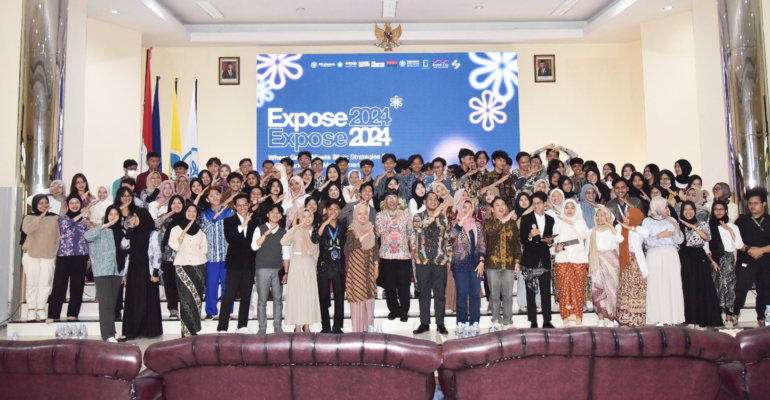This is How ARL IPB University’s Children Do SMEs, Expose 2024 Presents Practitioners, Reviews Sustainable Urban Landscape Management

Urban areas, with high population and building densities, face significant environmental challenges. These include air pollution, flooding and higher temperatures due to the urban heat island effect. This is partly due to the limited area of Green Open Space (RTH) and Blue Open Space (RTB).
The limited green and blue open space is caused by various factors, including land crisis, conflicting priorities among stakeholders, lack of local government budget, and ecological pressure. Nowadays, the need for green spaces in urban areas has become very important to create a healthy, balanced and sustainable environment.
In response to this problem, IPB University students from the Department of Landscape Architecture (ARL), Faculty of Agriculture organised ‘Expose 2024’ at the Auditorium of the Faculty of Mathematics and Natural Sciences (FMIPA), Dramaga Campus (21/5). IPB University students who are members of the 6th semester Landscape Management course raised the title “When Green Meets Blue: Strategies for Urban Landscape Management”.
The coordinator of the Landscape Management course, Prof Hadi Susilo Arifin, said that this Expose event has been held every year since 1999. “Expose 2024 raises the case of RTH and RTB in Sentul City and Kendal River Park in Cilincing District, North Jakarta. The study was conducted for four weeks in conjunction with the Teaching Practitioner programme,” explained Prof Hadi.
According to Prof Hadi, “Management is the last hand of a planning, design, construction or development process. So, the key to the success of a project depends on the hands of the manager.”
He emphasised that if every managing agency or institution conducts a good management plan, all landscape projects are expected to be sustainable.
The person in charge of the practicum, Dr Kaswanto, added that this year’s Expose was held in the work areas of the two Teaching Practitioners, namely Prastiti Handayani (Head of Service Management PT Sentul City Tbk) and Muhammad Ali (Section Head of the Parks Division, Department of Parks and Urban Forests, Jakarta Province).
“The management plan consists of six things, namely organisational structure, manpower, tools and materials, scheduling, cost budget, and implementation or method. The study results presented through Expose 2024 are expected to help students master the process and organise the six elements of an optimal and sustainable management plan,” he said.
Muhammad Ali, one of the Teaching Practitioners, said that the combination of RTH and RTB concepts is not difficult to implement. An example is Kendal River Park, which is dominated by RTB. “The existing condition is indeed rice fields, so functionally Kendal Park can be utilised as a productive landscape,” he said.
In addition, the composition of the developed open space can implement RTH and RTB with an ideal ratio. Meanwhile, Prastiti Handayani revealed that the utilisation of the eco-city concept is done by maintaining biodiversity and utilising the ecosystem relationship between RTH and RTB in harmony.
Expose 2024 coordinated by Rizky Azru Anwar, opened by the Head of the Department of Landscape Architecture, Dr Akhmad Arifin Hadi, was also attended by several students of S3 Natural Resources and Environmental Management (PSL) IPB University who are researching green spaces and green spaces.
“This year’s Expose products in the form of short videos, PPT presentations and standing banners, have been presented very well,” commented Hadi objectively. He hoped that the students could draw a common thread of the relationship between RTB and RTH, not only from theory, but also see directly the practice and implementation in the field. (*/Rz) (IAAS/RUM)



